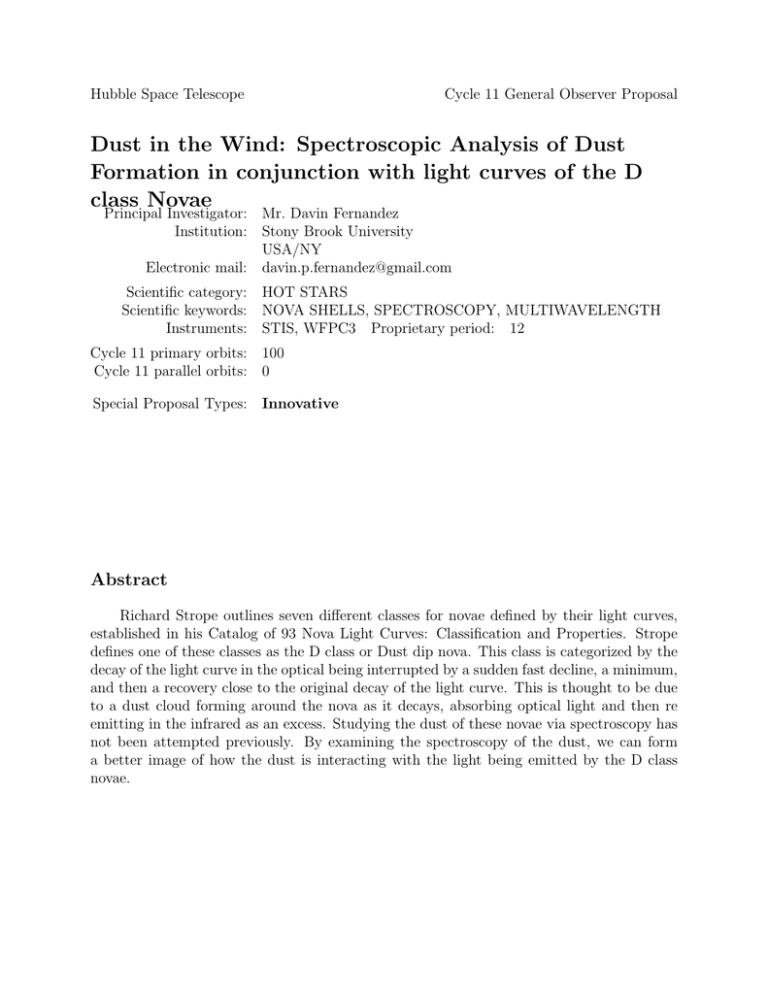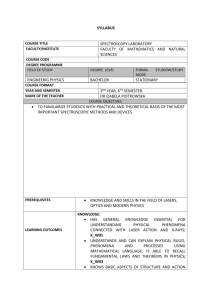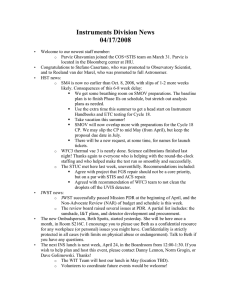Dust in the Wind: Spectroscopic Analysis of Dust class Novae
advertisement

Hubble Space Telescope Cycle 11 General Observer Proposal Dust in the Wind: Spectroscopic Analysis of Dust Formation in conjunction with light curves of the D class Novae Principal Investigator: Mr. Davin Fernandez Institution: Stony Brook University USA/NY Electronic mail: davin.p.fernandez@gmail.com Scientific category: HOT STARS Scientific keywords: NOVA SHELLS, SPECTROSCOPY, MULTIWAVELENGTH Instruments: STIS, WFPC3 Proprietary period: 12 Cycle 11 primary orbits: 100 Cycle 11 parallel orbits: 0 Special Proposal Types: Innovative Abstract Richard Strope outlines seven different classes for novae defined by their light curves, established in his Catalog of 93 Nova Light Curves: Classification and Properties. Strope defines one of these classes as the D class or Dust dip nova. This class is categorized by the decay of the light curve in the optical being interrupted by a sudden fast decline, a minimum, and then a recovery close to the original decay of the light curve. This is thought to be due to a dust cloud forming around the nova as it decays, absorbing optical light and then re emitting in the infrared as an excess. Studying the dust of these novae via spectroscopy has not been attempted previously. By examining the spectroscopy of the dust, we can form a better image of how the dust is interacting with the light being emitted by the D class novae. Mr. Davin Fernandez Dust in the Wind: Spectroscopic Analysis of Dust Formation in conjunction with light curves of the D class Novae Investigator Mr. Davin Fernandez PI: CoI: Total number of investigators: Observing Summary: Target RA M31N 00 42 42.66 2011-01A Institution Stony Brook University Country USA/NY 2 DEC 41 19 14.2 V 18.1 Configuration,mode,aperture spectral elements STIS/WFC3 SPECTROSCOPY/IMAGING Unknown STIS/WFC3 SPECTROSCOPY/IMAGING Total orbits 10 Flags DUP 10 DUP M31N 2010-12A 00 40 24.39 41 04 03.9 16.7 M31N 2010-10A 00 42 45.82 41 24 22.0 17.9 STIS/WFC3 SPECTROSCOPY/IMAGING 10 DUP M31N 2010-09A 00 42 23.32 42 17 08.6 17.2 STIS/WFC3 SPECTROSCOPY/IMAGING 10 DUP M31N 2010-08A 00 43 28.28 41 41 25.0 18.5 STIS/WFC3 SPECTROSCOPY/IMAGING 10 DUP M31N 2010-07A 00 43 20.11 41 21 23.7 20.6 STIS/WFC3 SPECTROSCOPY/IMAGING 10 DUP M31N 2010-06A 00 43 07.52 41 19 48.7 18.1 STIS/WFC3 SPECTROSCOPY/IMAGING 10 DUP M31N 2010-05A 00 42 35.90 41 16 37.5 17.6 STIS/WFC3 SPECTROSCOPY/IMAGING 10 DUP M31N 2010-04A 00 42 44.76 41 15 12.0 16.5 STIS/WFC3 SPECTROSCOPY/IMAGING 10 DUP M31N 2009-12A 00 40 19.41 41 15 47.6 16.6 STIS/WFC3 SPECTROSCOPY/IMAGING 10 DUP Grand total orbit request 100 2 Mr. Davin Fernandez Dust in the Wind: Spectroscopic Analysis of Dust Formation in conjunction with light curves of the D class Novae Scientific Justification Developing a complete picture of the processes surrounding a nova is integral to properly understanding the differences between each event. By examining the spectroscopy of the dust we can develop a better understanding of it’s composition while it forms around the D (Dust Dip) class of novae. From this, a correlation between the spectroscopy of the dust and the light curves of these novae can be developed. This connection between the attributes of the dust being formed and the resulting light curves of the D class novae will help in creating a more thoroughly detailed explanation of this classification. By using the spectroscopic analysis of the dust, a blackbody spectrum can be calculated for how the dust should be reradiating that absorbed light. This excess of light being re emitted in the infrared can then be estimated and compared to the observed differences in re emitted excess of the D class novae. Should none of the observed novae be D class, a spectroscopic image will still be compiled of each nova. Although the majority of novae seem to fall into the S (or smooth) class of novae, developing a spectroscopic understanding of these common S class novae will still prove helpful in constructing the baseline image of novae and thus the subtle differences between the other classes as they deviate. The current understanding of novae and how they differ from one another is based purely on the characteristics of the light curve of each novae. Through an examination of the physical phenomena thought to be occuring around these novae, a more concrete example can be developed upon which our classification system can be based. This development of a model nova will lead to an improved basis from which other models of nova classes can be built. Description of the Observations I will be observing 10 different novae in the M31 (Andromeda) Galaxy. Each nova will be observed for 10 orbits, requiring a total of 100 orbits for observations. Each nova will be observed in the optical wavelength as well as a spectroscopic image of the nova. Each nova should have an exposure time of 5 to 10 seconds for each wavelength (I,B,V, and K) as well as 10 seconds for their spectroscopy. This will require a total exposure-time of 3000 to 5000 seconds for all observations. Special Requirements The light curves of novae are time-sensitive due to the decay rate of the novae. Because of this, the novae should be observed as close to the initial time of the nuclear fusion flash as possible. Coordinated Observations These observations will not be affiliated with any other facilities. 3 Mr. Davin Fernandez Dust in the Wind: Spectroscopic Analysis of Dust Formation in conjunction with light curves of the D class Novae Justify Duplications Measuring the light curves of these novae will help to reaffirm the decay rates and attributes of the novae when the spectroscopic images are compared to their corresponding light curves. Previous HST Programs None. 4




